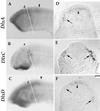Lamprey Dlx genes and early vertebrate evolution
- PMID: 11172008
- PMCID: PMC29314
- DOI: 10.1073/pnas.98.4.1665
Lamprey Dlx genes and early vertebrate evolution
Abstract
Gnathostome vertebrates have multiple members of the Dlx family of transcription factors that are expressed during the development of several tissues considered to be vertebrate synapomorphies, including the forebrain, cranial neural crest, placodes, and pharyngeal arches. The Dlx gene family thus presents an ideal system in which to examine the relationship between gene duplication and morphological innovation during vertebrate evolution. Toward this end, we have cloned Dlx genes from the lamprey Petromyzon marinus, an agnathan vertebrate that occupies a critical phylogenetic position between cephalochordates and gnathostomes. We have identified four Dlx genes in P. marinus, whose orthology with gnathostome Dlx genes provides a model for how this gene family evolved in the vertebrate lineage. Differential expression of these lamprey Dlx genes in the forebrain, cranial neural crest, pharyngeal arches, and sensory placodes of lamprey embryos provides insight into the developmental evolution of these structures as well as a model of regulatory evolution after Dlx gene duplication events.
Figures







Similar articles
-
Otx expression during lamprey embryogenesis provides insights into the evolution of the vertebrate head and jaw.Dev Biol. 1999 Mar 1;207(1):26-37. doi: 10.1006/dbio.1998.9163. Dev Biol. 1999. PMID: 10049562
-
Isolation of Dlx and Emx gene cognates in an agnathan species, Lampetra japonica, and their expression patterns during embryonic and larval development: conserved and diversified regulatory patterns of homeobox genes in vertebrate head evolution.J Exp Zool. 2001 Apr 15;291(1):68-84. doi: 10.1002/jez.6. J Exp Zool. 2001. PMID: 11335917
-
Amphioxus and lamprey AP-2 genes: implications for neural crest evolution and migration patterns.Development. 2002 Nov;129(21):4953-62. doi: 10.1242/dev.129.21.4953. Development. 2002. PMID: 12397104
-
Evolution of the vertebrate jaw from developmental perspectives.Evol Dev. 2012 Jan-Feb;14(1):76-92. doi: 10.1111/j.1525-142X.2011.00523.x. Evol Dev. 2012. PMID: 23016976 Review.
-
Lamprey as an evo-devo model: lessons from comparative embryology and molecular phylogenetics.Genesis. 2002 Nov;34(3):175-83. doi: 10.1002/gene.10142. Genesis. 2002. PMID: 12395382 Review.
Cited by
-
Developmental and evolutionary significance of the mandibular arch and prechordal/premandibular cranium in vertebrates: revising the heterotopy scenario of gnathostome jaw evolution.J Anat. 2013 Jan;222(1):41-55. doi: 10.1111/j.1469-7580.2012.01505.x. Epub 2012 Apr 16. J Anat. 2013. PMID: 22500853 Free PMC article. Review.
-
Evolution of the vertebrate jaw: comparative embryology and molecular developmental biology reveal the factors behind evolutionary novelty.J Anat. 2004 Nov;205(5):335-47. doi: 10.1111/j.0021-8782.2004.00345.x. J Anat. 2004. PMID: 15575882 Free PMC article. Review.
-
Expression of Sox family genes in early lamprey development.Int J Dev Biol. 2012;56(5):377-83. doi: 10.1387/ijdb.113416bu. Int J Dev Biol. 2012. PMID: 22811271 Free PMC article.
-
The role of gene duplication in the evolution and function of the vertebrate Dlx/distal-less bigene clusters.J Struct Funct Genomics. 2003;3(1-4):151-9. J Struct Funct Genomics. 2003. PMID: 12836694 Review.
-
Developmental evidence for serial homology of the vertebrate jaw and gill arch skeleton.Nat Commun. 2013;4:1436. doi: 10.1038/ncomms2429. Nat Commun. 2013. PMID: 23385581 Free PMC article.
References
Publication types
MeSH terms
Substances
Associated data
- Actions
- Actions
- Actions
- Actions
Grants and funding
LinkOut - more resources
Full Text Sources

